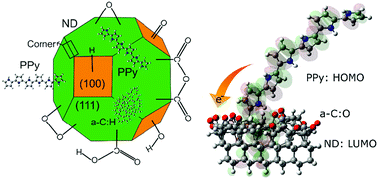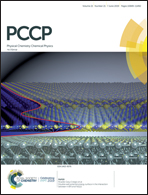DFT calculations reveal pronounced HOMO–LUMO spatial separation in polypyrrole–nanodiamond systems†
Abstract
The low-cost efficient generation of renewable energy and its blending with societal lifestyle is becoming increasingly pervasive. Diamond-based inorganic–organic hybrid systems may have an immense, yet still mostly unexplored, potential in photovoltaic solar cells applications. In this work, we study the interactions of polypyrrole (PPy) with diamond nanoparticles (so-called nanodiamonds, NDs) by computational density functional theory (DFT) methods. We compute the structural and electronic properties of such hybrid organic–inorganic systems. During modeling, PPy is chemisorbed and physisorbed on (111) and (100) ND edge-like surface slabs terminated with oxygen, hydroxyl, carboxyl, and anhydride functional groups, i.e., in the arrangements most commonly found in real NDs. Moreover, NDs terminated with an amorphous surface layer (a-C:H, a-C:O) are considered to approach realistic conditions even further. In a predominant number of cases, we obtain the spatial separation of HOMO and LUMO at the interface, facilitating exciton dissociation. Further, there is a favorable energy level alignment for charge transport. The theoretical results, therefore, show the promising potential of PPy–ND composites in photovoltaic applications.



 Please wait while we load your content...
Please wait while we load your content...